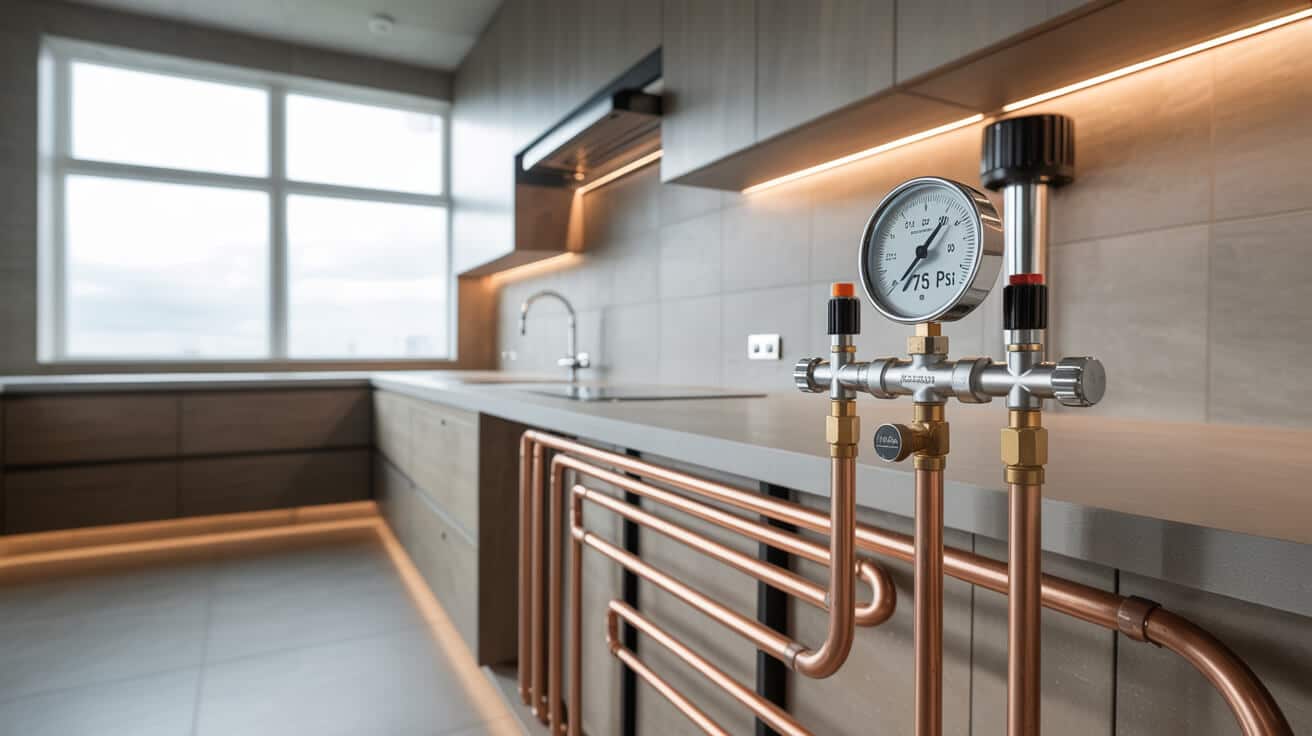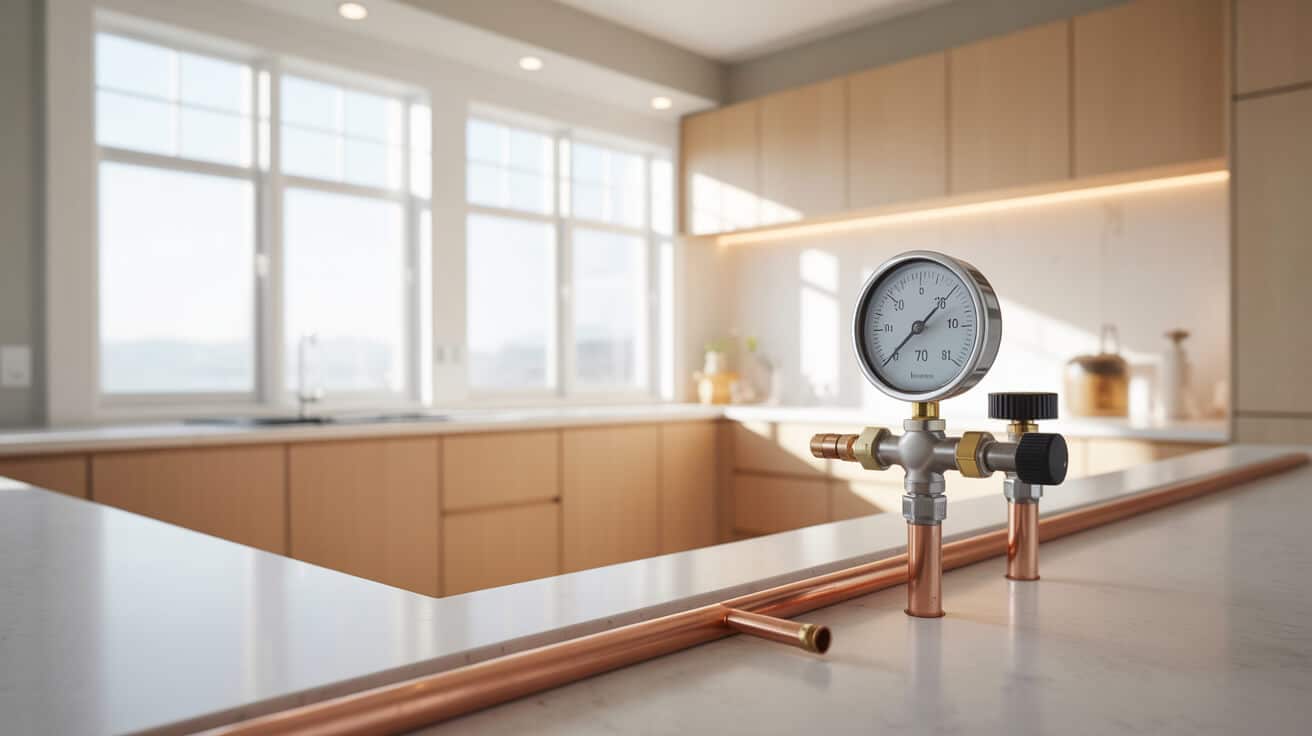Pressure retention testing protects occupants and structures by identifying leaks that visual inspection cannot detect, and is critical for safeguarding insurance eligibility, legal compliance, and operational continuity. Within the United Kingdom, companies such as Plumbers 4U perform these tests across all property types—residential, commercial, institutional—supporting your investment, reputation, and safety obligations. The procedure, defined by statutory and industry standards, reduces the possibility of water or gas escapes and the financial impact of undiagnosed system failures, bridging professional engineering practice with evolving legal frameworks.
Etymology or name origin
The expression “pressure drop test” draws on physics terminology, combining “pressure drop” (the measurable decrease in fluid or gas pressure across a system) and “test” (a systematic evaluation). The term entered professional trade vernacular in the postwar era, first cited in engineering literature and later codified by technical bodies such as the WRAS and British Standards. Present usage encompasses the process itself and the underlying principle of diagnosing invisible system losses by observable pressure variation.
Overview / context
Pressure drop evaluation is a cornerstone of building services engineering, bridging proactive defect prevention with required compliance milestones. Its scope encompasses initial installations, major refurbishments, emergency troubleshooting, and compliance regimes throughout the lifecycle of your property or business asset. A successful test assures that all joints, fixtures, and pipes function as specified, providing crucial data for asset management, insurance, and regulatory handover.
General purpose
- Leak prevention: Detects unseen faults, reducing waste and safeguarding interiors.
- Certification: Fulfils regulatory and insurance obligations.
- Asset management: Essential for lifecycle documentation and valuation.
Scope within building services
Testing applies to:
- New builds and renovated properties;
- Major plantrooms;
- Domestic water, central heating loops, underfloor heating, and gas pipelines;
- Asset transition events (handovers, lease changes, insurance audits).
Company role and responsibilities
Plumbers 4U and industry peers are responsible for:
- Planning and performing tests to British and EU standards;
- Issuing compliant documentation for your records and regulatory files;
- Diagnosing, repairing, and certifying systems post-failure.
Implications for property type
- Homeowners: Pressure loss threatens fabric and value; early testing saves future expense.
- Landlords/agents: Certification supports legal defence and audit trails.
- Facilities & asset managers: Compliance routines mitigate risk and optimise planned maintenance.
History
Early methods
Leak testing emerged from practical necessity—historically using rudimentary water-filling and visual spot checks. These early routines provided no measurable standard and failed to detect subtle or chronic faults.
Standardisation and regulation
The industrialization of the UK prompted the creation of harmonised plumbing standards late in the 19th century, but codified pressure retention protocols became policy following mid-20th-century building control reforms. Key milestones include:
- Water Supply (Water Fittings) Regulations 1999: Focused on water conservation, contamination prevention, and explicit commissioning requirements.
- Building Regulations Parts G (Sanitation) and H (Drainage): Formalised pressure-based testing.
- Adoption of British Standards (BS 6700, BS EN 806): Unified process, pass/fail criteria, documentation protocols across the sector.
Emergence of digital practices
Recent decades brought:
- Digital recording equipment and cloud-based reporting systems for precise audit trails.
- Enhanced risk assessment and method statements (RAMS).
- Seamless integration of pressure drop testing into planned preventive maintenance (PPM) and compliance auditing across your portfolio.

Concept / description
Pressure drop assessment leverages the static pressure principles of fluid mechanics: a closed, stabilised system will retain its applied load unless a leakage path exists. By monitoring pressure decay under prescribed conditions, operatives diagnose minute or systemic failure in pipelines, joints, and equipment.
Foundational science
- Hydrostatics and physics: Fluid-filled systems resist pressure loss if composed and joined correctly; any drop reflects a loss of fluid/gas or material absorption defects.
- Thermal equilibrium: Controlled ambient temperature is essential, since thermal expansion or contraction can cause spurious readings.
Sealed systems and pressure differentials
- Isolate all sections with end caps, plugs, or valves.
- Introduce the appropriate test media (usually water for most plumbing; air for certain specialty cases).
- Pressurise the system to an industry-mandated percentage above operational norm (e.g., 1.5× working pressure).
- Record initial and final readings, with regular monitoring intervals.
Key physical parameters
- Test media: Water, air, or inert gas depending on system specification.
- Test pressure thresholds: Established by system type and manufacturer specifications.
- Duration: Standard intervals vary from 10 to 60 minutes, defined in regulatory tables for different applications.
- Permissible loss: Expressed in Pascals (Pa) or Bars (1 bar = 100,000 Pa).
Methodology
Effective pressure drop analysis combines standardised execution with professional judgement. Each step, from setup to results archiving, underpins the confidence you can place in the system and its compliance status.
Preparatory procedures
- Confirm the exact extent and contents of the test section to avoid system or equipment damage.
- Drain pipes (if necessary for hydraulic tests); isolate boilers, cylinders, or appliances.
- Secure all connections, instal gauge and pump adapters, and fit physical boundary devices (caps/plugs).
- Inspect for obvious deterioration before proceeding.
Test media selection
- Water: is the default for most domestic systems.
- Air: is used for systems sensitive to corrosion, or where fluid introduction might result in operational issues.
- Inert gas: for specialised or hazardous environments, subject to risk assessment.
- Selection criteria include system material, intended use, and safety margin.
Sequence of operations
- Introduce chosen test media.
- Gradually increase pressure using a calibrated pump, monitoring to prevent overshoot.
- Allow stabilisation for thermal/pressure equalisation.
- Record initial pressure, time, temperature, and system status.
- Monitor and record readings at fixed intervals.
- Remove test media as required after successful completion.
Data collection
- Structured logbook or digital recording.
- Identification of test region, date/time, responsible engineer, and client.
- Record of equipment IDs, calibration data, and environmental factors for traceability.
Trouble-shooting and retest protocols
- Should loss exceed allowable limits:
- Employ leak-tracing apparatus: acoustic detectors, chemical tracers, or infrared cameras.
- Isolate sub-sections to localise faults, then repair.
- Retest to confirm compliance before issuing documentation.
Tools and equipment
Measurement and pressurisation devices
- Test pumps: Hand or electric, pressure-rated.
- Pressure gauges: Analogue (mechanical dial) or digital (with memory/data export), accurate to regulatory requirement.
- Caps/plugs/adapters: To secure all open ends and create isolated zones.
- Data loggers: For long-duration, high-precision, or multi-zone systems.
Ancillary tools
- Leak detection agents: Chemical dyes, soapy solutions, ultrasonic sensors.
- Calibration equipment: For verifying accuracy before and after each sequence.
| Tool | Application Area | Special Feature | Calibration Required |
|---|---|---|---|
| Hand pump | Domestic, light commercial | In-situ use, quick setup | Annually |
| Electric pump | Large/commercial systems | High output, rapid fill | Annually |
| Digital gauge | QA/audit, multipoint | Data export/logging | Annually |
| Leak detection | Diagnostics | Pinpoint small losses | Manufacturer-specified |
Maintenance and compliance
Plumbers 4U invest in thorough maintenance and documentation of testing equipment. Your project will benefit from tracked instrument history and traceable calibration logs, supporting certification reliability and compliance with ISO standards.
System types and applications
Domestic installations
- Testing of first-fix (pre-board) pipework during new construction.
- Fault diagnosis in refits and emergency maintenance.
- Post-incident validation before insurance claims or new occupancy.
Commercial systems
- Multi-zone plantrooms, large offices, hotels, and schools undergo phased testing as integral to facilities protocols.
- Annual or semi-annual testing as part of professional PPM strategies.
Asset management
- All pressure results are logged for lifecycle analysis, reinvestment planning, and scheduled replacement of ageing infrastructure.
Lifecycle and compliance events
- Handovers, insurance renewals, new tenant occupancy, and end-of-warranty checks routinely require current pressure test documentation to support risk allocation.

Professional roles and stakeholders
Professional practitioners
- Licenced plumbing and heating engineers trained in the apposite UK/EU methodologies.
- commissioning agents and quality assurance officers responsible for sign-off.
Oversight and documentation roles
- Facilities, property, and asset managers document, track, and interpret testing cycles for compliance and operational readiness.
End users and beneficiaries
- *Homeowners*: Direct assurance of system condition.
- *Landlords/agents*: Evidence for deposit discussions, rent release, compliance checks.
- *Asset/institutional managers*: Insight for insurance, funding, and facilities audit.
Legal, regulatory, and compliance framework
Statutory regulations
- Water Supply (Water Fittings) Regulations 1999: Legal basis for all water-containing system testing and commissioning.
- Building Regulations (Part G/H): National construction requirements, enforceable by Building Control or inspectors.
- BS/EN/ISO standards: Guide pressure values, test conduct, recording formats, pass/fail metrics.
Company and contractor duties
- Confirm every system is tested as-built, retested after repair.
- File signed certificates/logs for customer or organisational records.
- Notify clients of all deviations from expected or historical performance.
Logbooks, digital certification, audit trails
- All results are permanently archived by Plumbers 4U, retrievable by asset managers, facilities teams, or property owners on request.
- Digital certificates and logs allow your business, insurer, or compliance team instant verification.
Data, performance, and measurement
Standard pass/fail criteria
- UK standard (domestic): Maximum 0.2 bar pressure loss over 30 minutes, at stable temperature.
- For complex or commercial systems, adjusted by surface area, system type, or usage pattern.
Impacts of environmental factors
- Test is not valid unless stabilised temperature and pressure achieved.
- Ambient temperature logged for every result; transient barometric fluctuations accounted for.
Instrument error and prevention
- Only company-calibrated instruments, with up-to-date certificates, are permitted by Plumbers 4U.
Challenges, barriers, and limitations
Common sources of error
- Failure to fully isolate a system (e.g., missed valve, incomplete fitting closure).
- Thermal expansion during pressurisation offsetting true performance.
- Air entrapment in fluid-based systems gives false negative results.
- Uncalibrated, damaged, or inappropriate test equipment.
Attendant risks and controls
- Injury risk in improperly managed pneumatic/air-based testing; only trained engineers may employ these protocols.
- Fragile or aged piping may become further compromised under test conditions.
- Thorough risk assessments, RAMS statements, and operator training mitigate these effects.
Comparative methods
- *Acoustic or thermal scanning* enhances test precision when formal results are ambiguous or contested.
- *Flow metering* and post-test observation serve as complementary verification methods for chronic problems.
Outcomes and remediation
Failed pressure tests initiate targeted repairs:
- Adjust or replace failed joints, sections, valves, or fixtures as indicated by diagnostic testing.
- Certification only issued on successful retest with documented results.
- All remedial activities and retest data are logged into your property/asset management plan.
Impact, influence, and legacy
- Testing is a recognised anchor of modern facilities maintenance, underpinning reliability and insurance eligibility.
- Robust customer documentation provides high-value evidence for regulatory and commercial auditors.
- Professional implementation by firms like Plumbers 4U signals commitment to duty of care and asset preservation.
- Testing records enhance property valuation and streamline future services, benefitting owners, buyers, and service providers.
Future directions, cultural relevance, and design discourse
Regulatory and stakeholder expectations are converging on an environment where pressure drop testing is integral at every lifecycle stage. The symbolic value—proof of responsible stewardship and risk management—continues to rise for homeowners, professionals, and company custodians. Emphasis on transparency, digital records, eco-sensitivity, and mass professional training is shaping how services like those offered by Plumbers 4U remain essential to both asset protection and evolving legislation. The boundary between routine maintenance and proactive risk control is narrowing, with pressure drop assessment standing as a model for future building safety and management culture.

